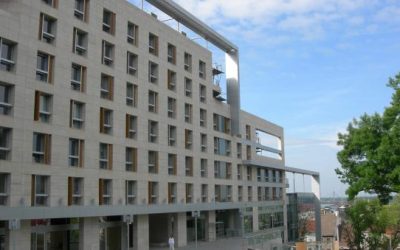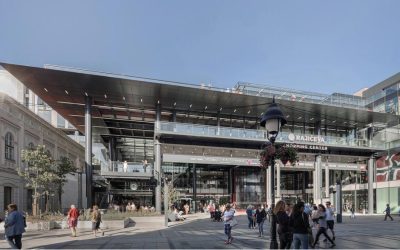Authors: Milena Kordić and Andrej Dolinka
Tuesday, 22 April 2025.
19.00 OPENING OF THE EXHIBITION
(22.04–17.05.2025)
→ CCB, Art and Artget Gallery, Knez Mihailova 6
The PUBLICness of ARCHITECTURE
Architecture is the most public of all arts.
Rem Koolhaas, S, M, L, XL (1995)
Twenty years ago, the first Belgrade Architecture Week (BINA 2004) began as “an invitation to Belgradians to get closer to architecture. Believing that understanding the built environment and participating in its improvement should not remain the privilege of the architectural ‘elite’ alone, fellow citizens will be offered the opportunity to engage in current architectural developments on both the domestic and international scene through a series of exhibitions, lectures, workshops, panels and film screenings.”
With this initial ambition and subsequent duration, BINA encourages interest in the built environment and conversations about architecture in the wider social field, which can lead to the creation of conditions for the revival of architecture criticism, which is much needed in our environment.
The term architecture criticism implies the process of analysis, assessment and interpretation of architectural works in order to understand their values, in different aspects, of which functionality and aesthetics are the most recognizable. Even more important is the recognition of the cultural, social and technological effects of architecture on the community. They influence our understanding of the relationship between people, ideas and space and consequently contribute to the orientation of the individual in the lived reality.
Establishing the field of architecture criticism enables a dialogue between architects, users and the general public about the environment, space, program and social responsibility of architecture. Through this dialogue, a two-way relationship of responsibility is established – that of architects towards the community and the community towards architecture. The field of criticism thus becomes an instrument of self-regulation of the quality of architecture and the culture of living.
One of BINA’s last themes, THE GOOD (urban) LIFE, summarizes that type of relationship through the timeless ideal of architecture – the struggle for a better world.
On the other hand, the Lifetime Achievement Award of the Association of Architects of Serbia (UAS) was established in 1982 and since then has been awarded to prominent architects whose work has left a significant mark on Serbian architecture. In addition to the role it has in valuing, affirming and promoting the architectural activity of recognized individuals, which is usually associated with such awards, it can also be seen as one of the bases for the development of architectural criticism in our country. This award is given to authors whose work has left a deep mark, both in terms of formal and social, cultural and theoretical contributions to architecture.
In regards to the establishment and institutionalization of architecture criticism, several initiatives for the formation of the Center for Architecture appeared, among which was BINA. The Center for Architecture could play a key role in improving the history, theory and criticism of contemporary architecture in Serbia, and thus contribute to better and more responsible urban and architectural practices.
First of all, in an institution such as the Center for Architecture, an Archive of projects of contemporary architectural practice could be established, which would be accessible to researchers, as well as enable exposition and educational programs that would improve knowledge and critical thinking among architects, students and the wider society. The documentation related to the winners of the UAS Lifetime Achievement Award can be a solid basis for such an archive.
Awards such as this, when viewed as part of a wider critical field, function not only as recognition but also as a mirror of socio-cultural and professional currents in architecture. Similar intentions are related to this exhibition – not only to present the achievements of respected individuals, but to show the potential of documented knowledge about their work.
The regular exhibiting of architectural projects and works of young architects, as well as retrospectives of important architectural works and personalities, allows the field of architectural knowledge to expand and upgrade.
The architecture criticism, through the written word, essays and reviews is a powerful tool for forming critical awareness and directing public and professional discussion. Panels and lectures in the field of architecture and urbanism enable direct interaction between professionals, critics, students and a wider audience. This is a space for dialogue on current issues, challenges and trends in architecture that BINA opens every year.
The Center for Architecture enables the practice of architectural criticism to expand beyond the professional circle to the social and cultural public, including students, citizens and decision makers. Critical consideration of the existing as well as emerging architecture is of fundamental importance for more active involvement of wider circles in the processes of planning and construction of space. The exhibition The PUBLICness of Architecture highlights another important challenge – connecting different generations of architects and critics. Youth initiatives can be encouraged through mentorship and collaboration with older colleagues, which develops the continuity of critical thinking and improves architectural criticism.
Already for two decades BINA has been initiating important conversations about architecture, thus creating space for the development of the necessary field of architectural criticism. Although there have been numerous attempts to evaluate and analyze architectural production, a critical platform has not yet been established that would thoroughly examine how the profession and discipline affect the community, that is, what are the values, achievements and challenges of architecture as a social practice. Despite epochal social, technological and media changes, in the fields of other artistic disciplines such as visual arts, music and literature, criticism still finds channels of communication and remains an important part of the system. In architecture, however, this is not the case. Attempts to establish magazines and platforms dedicated to architecture often end up as commercial projects, connecting manufacturers of materials, equipment and investors with architects and designers. Although this aspect of architecture is important, it thwarts criticism due to the nature of the material relations that prevail in it. There is a lack of criticism that is enlightened in the social context, criticism that would allow a free and independent consideration of architectural achievements, directions of development and weaknesses of existing tendencies, without political or commercial pressures. This kind of criticism is conspicuously lacking in architecture in today’s Serbia.







